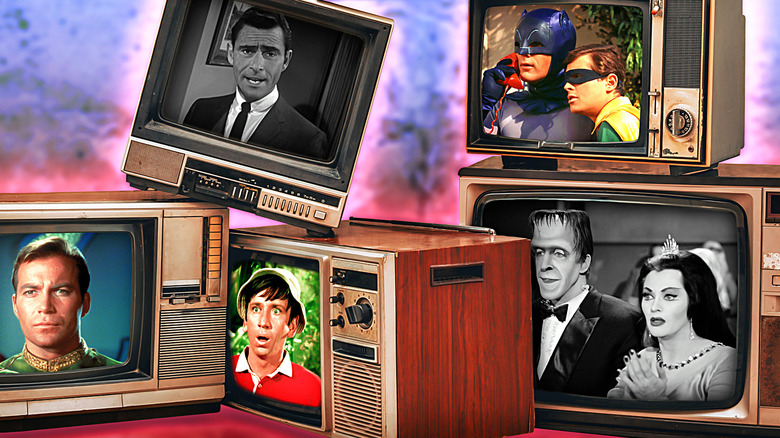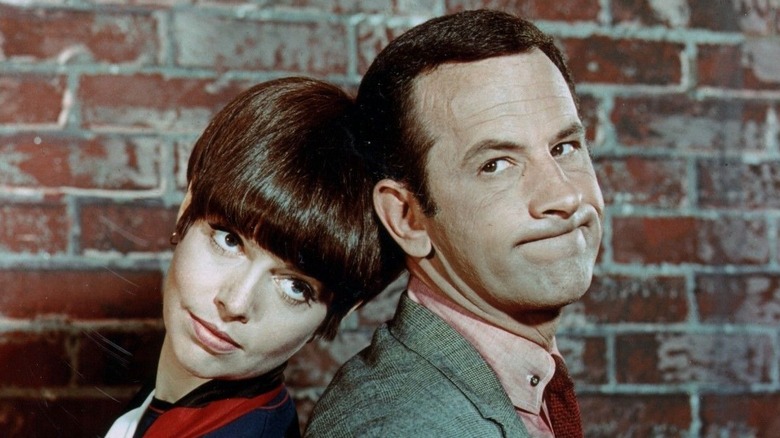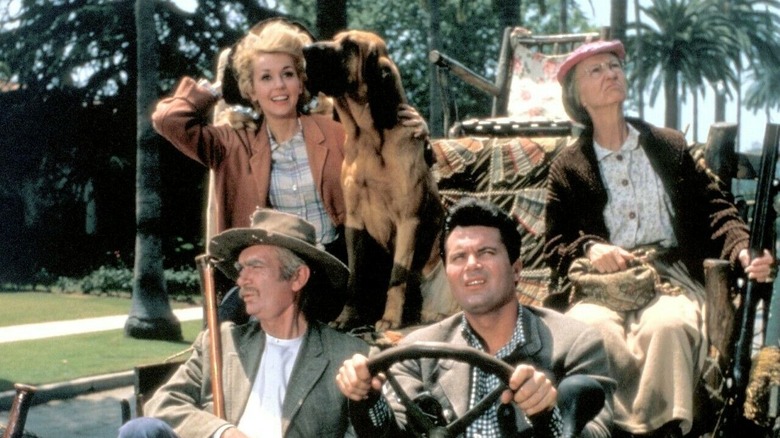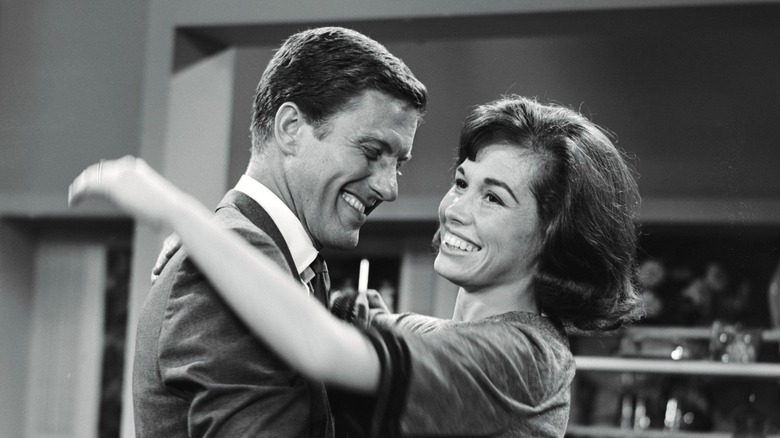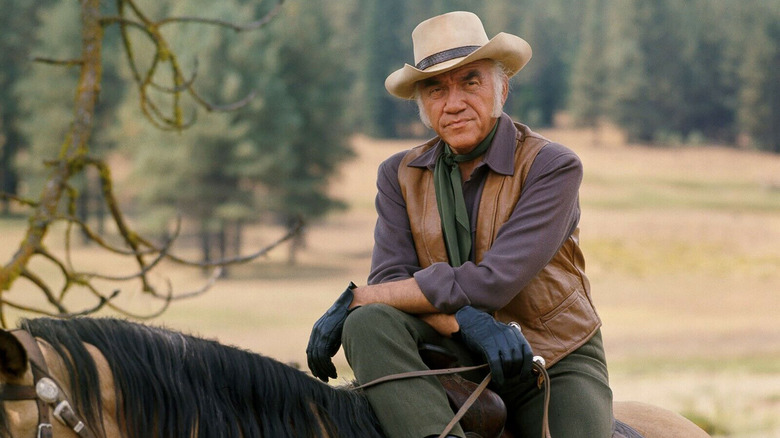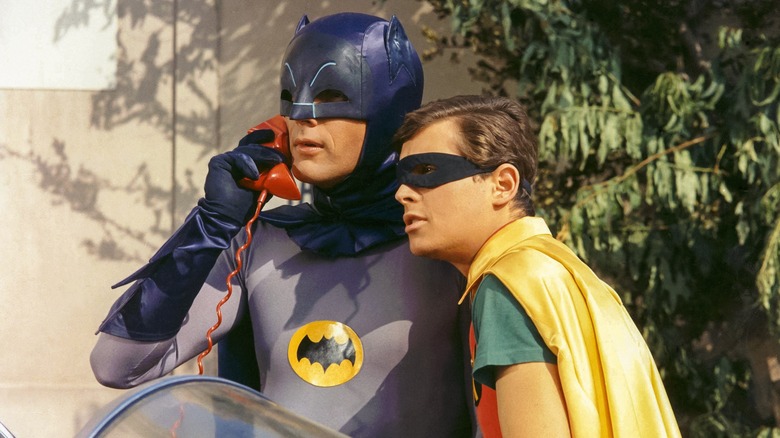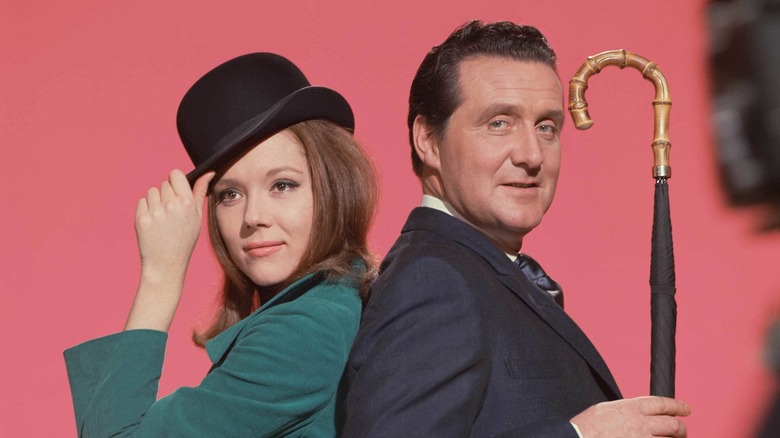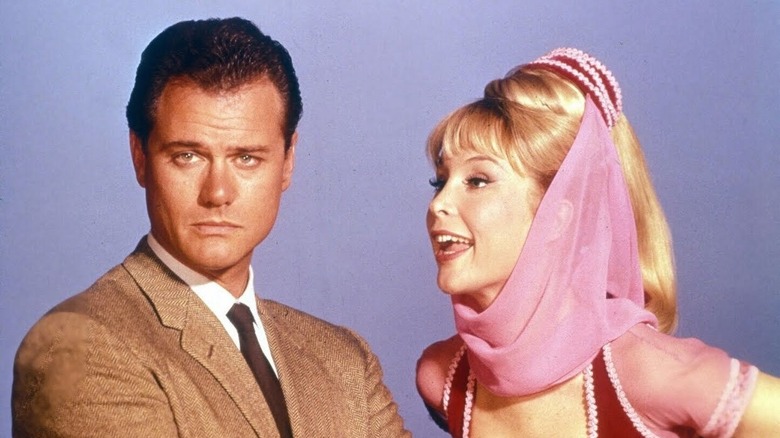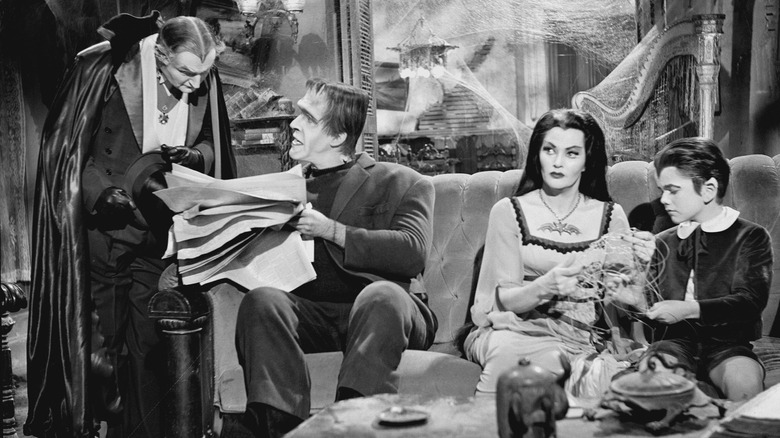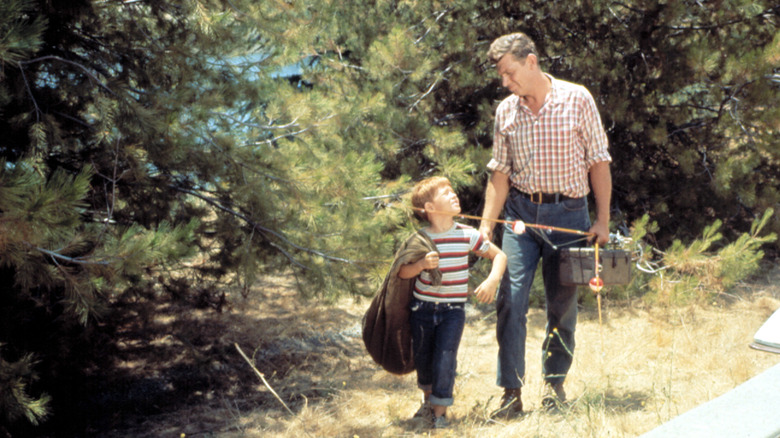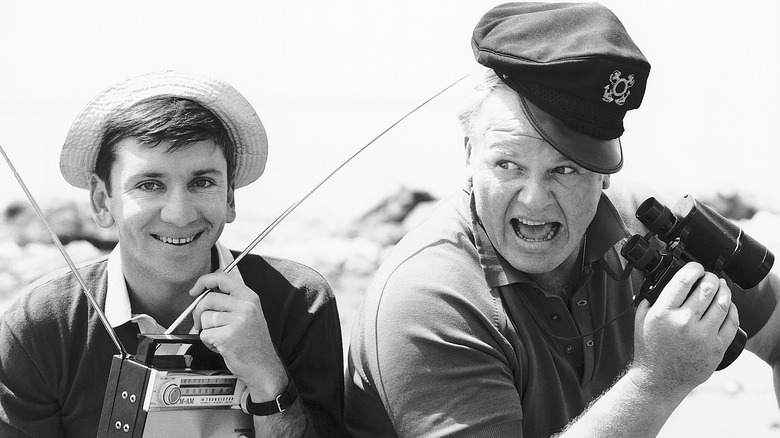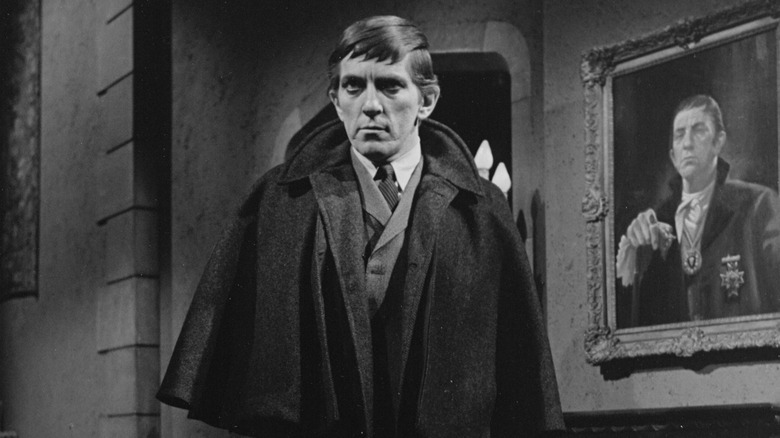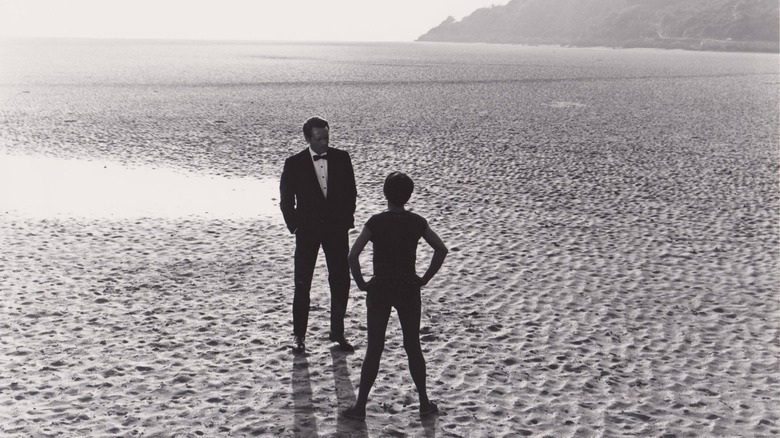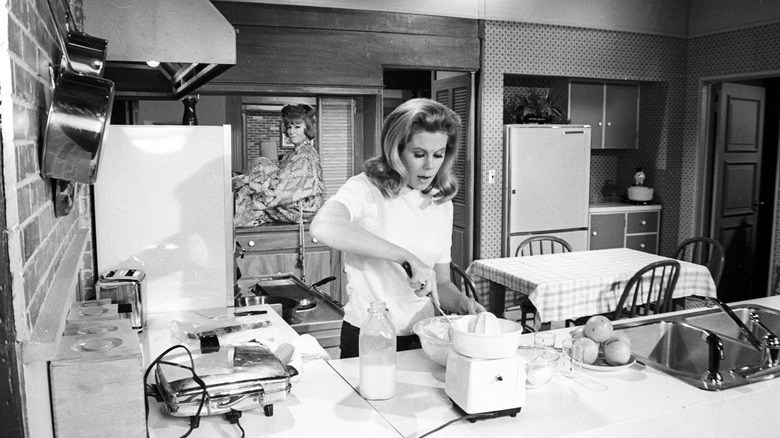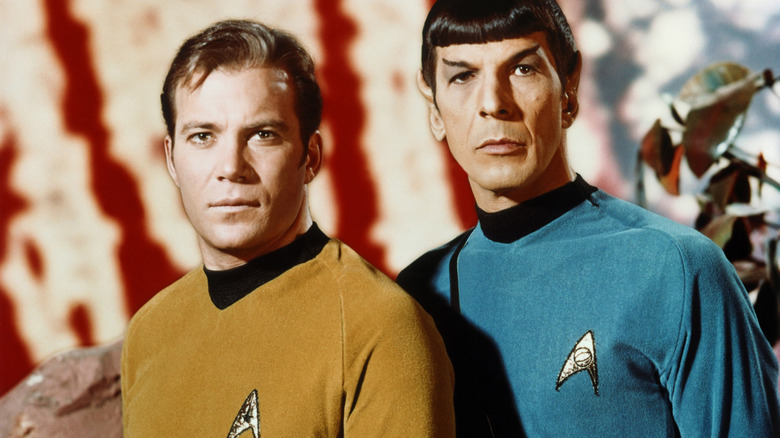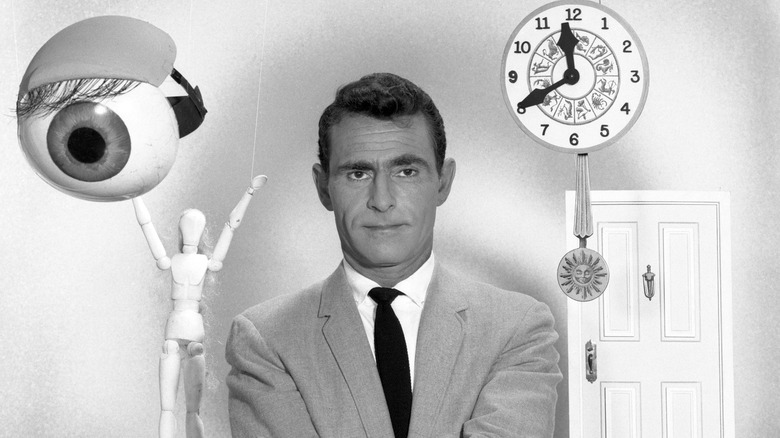The 15 Best TV Shows Of The 1960s
Although most of today's viewing audiences weren't watching 1960s television live, it speaks to the quality and relatability of shows from that decade that many of its shows are cemented in popular culture. If they're not being rerun on cable or made available on several different streaming apps, they're being transformed for modern viewers with feature-length homages, for better or worse.
From spy dramas and family sitcoms to science fiction adventures and dark gothic soap operas, the 1960s had a little something for everyone. When we look back on the decade's television, we see a rapidly changing landscape, one where shows nostalgic for a simper time screen opposite imaginative, forward-thinking programs. Although many 1960s shows feel very much of their time, there's a stylish charm that makes them still enjoyable to watch today.
Here are some of the best TV shows that the 1960s has to offer — take a quick read through and relive all of your most cherished Nick at Nite memories.
Get Smart
The 1960s birthed one ultra-cool super spy with Sean Connery's James Bond, but if that's the kind of secret agent you want to watch, "Get Smart" is probably not the first place to look. Starring Don Adams as Maxwell Smart (also known as Agent 86), "Get Smart" envisions the career of an intelligence officer where things usually end up alright in the end, but not without some comical hijinks along the way. Smart is defined by his clumsiness and general ineptitude, counterbalanced by the skill and professionalism of his fellow operative and love interest Agent 99, played by Barbara Feldon.
"Get Smart" revolutionized the parodying of the spy genre, then extremely popular among Cold War audiences. It ran for five seasons, first on NBC and then on CBS, and it launched the careers of its showrunners, Mel Brooks and Buck Henry. "Get Smart" eventually earned four feature-length spinoffs, including a high-profile Hollywood production starring Steve Carell and Anne Hathaway in 2008.
The Beverly Hillbillies
There's nothing like a good fish out of water story. When the Clampetts strike it rich thanks to a newfound oil claim back in Texas, they pack up their jalopy and head west, all the way to Beverly Hills, California. But although they may have the money to afford property in one of the country's most exclusive zip codes, that doesn't mean they fit in among their more well-heeled neighbors. Hence, "The Beverly Hillbillies." Naturally, comedy ensues.
"The Beverly Hillbillies" was a massive hit for CBS, and it ran for nine seasons from 1962 to 1971. Although it was cancelled in the 1970s as part of a work towards more urban programming — often referred to as the "Rural Purge," where all the folksy, small-town shows got the axe — "The Beverly Hillbillies" was still popular enough that it generated a 1981 made-for-TV movie, a 1993 reunion special, and a feature-length remake also released in 1993 starring Jim Varney and Cloris Leachman.
The Dick Van Dyke Show
Starring Dick Van Dyke as a version of himself, "The Dick Van Dyke Show" follows television writer Rob Petrie as he attempts to juggle his personal and professional life. His job gives audiences a glimpse into the glamorous world of 1960s television production in Manhattan, while his time spent at home models his idyllic marriage with Laura (Mary Tyler Moore).
Frankly, the entire show runs on the charm and chemistry of its two lead performers (and Van Dyke's famous pratfalls, of course), and it lasted for five seasons on CBS. But it wasn't just audiences who fell in love with "The Dick Van Dyke Show" — it was also a critical darling, taking home 15 Emmy awards over the years, including a combined five for its Van Dyke and Moore. It made both of them into bona fide stars, with Van Dyke starring in "The New Dick Van Dyke Show" for three seasons beginning in 1971 and Moore making TV history with her immensely popular "The Mary Tyler Moore Show" in 1970.
Bonanza
The 1960s were essentially the last big hurrah for the Western genre, which went from being ultra-popular to a niche rariety over the decades since. But while Westerns were already starting to fade on the big screen as the '60s began, the genre held out on television a little bit longer, its focus on law and order in the Old West a perfect backdrop for episodic storytelling. "Bonanza" was perhaps the most famous of these, running on NBC for an astonishing 14 seasons from the tail end of 1959 all the way through 1973.
Over the course of its 432 episodes, it follows the wealthy Cartwright family in Virginia City, Nevada, flipping the script on the typical old timey procedural that was popular for Westerns at the time. Instead, it focuses on the family drama between the Cartwright patriarch Ben (Lorne Greene) and his three sons, who are all very different from one another but love each other all the same. This approach allowed "Bonanza" to stand out from the crowd of Westerns, and ensured that audiences would connect emotionally with the show's characters.
Batman
Holy nostalgia, Batman! Although the DC superhero has been a big screen staple ever since the late 1980s, one of the most memorable iterations of the character was actually seen on television back in the 1960s, with Adam West donning the cowl and cape. These days, Batman has a reputation for being one of DC's darkest and grittiest superheroes (thanks in part to Christopher Nolan's trilogy of genre-defining "Batman" films), but back in the day, the character was camp with a capital C. The entire show was unafraid to be completely off the wall, secure in the knowledge that it was providing something novel — albeit a little silly — for television audiences.
"Batman" is responsible for not only defining the characters of Batman and Robin for a generation of viewers, but also introducing the murderers' row of villains, many of whom remain the gold standard to this day. Consider, for example, Eartha Kitt as Catwoman, or Cesar Romero as the Joker. Sure, there have been great incarnations of the characters in the years since, but they're undeniably a tough act to follow.
The Avengers
No, not those Avengers. A spy drama out of Great Britain, "The Avengers" starred Patrick Macnee as Jonathan Steed, a sort of small-screen version of James Bond, on his various missions. But although Steed was the starring role, the show quickly became famous for its roster of assistants, many of whom bucked the trends for female characters of the time. (The first assistant Cathy Gale, played by Honor Blackman, was in her 30s, a sharp contrast to the much-younger actresses playing similar supporting roles in other shows, for example.)
After Gale, there was Emma Peel, played by Diana Rigg — modern audiences may recognize her for her work as the scheming Olenna Tyrell on "Game of Thrones." Known for its then cutting-edge mod style and ability to shift with the times over the course of the rapidly-evolving 1960s, "The Avengers" ran for eight years on ITV, and was rebooted as "The New Avengers" in the mid-1970s. That show, although still starring Macnee in the lead role, only ran for two seasons.
I Dream of Jeannie
Essentially, "I Dream of Jeannie" saw what "Bewitched" was doing in 1964 and decided to double down on the supernatural family sitcom concept the following year. Larry Hagman plays Tony Nelson, an astronaut (it was apparently prerequisite for 1960s sitcoms that all of the male leads had to have very cool and glamorous jobs) who ends up discovering a magic lamp after his ship lands on a deserted island.
Inside the lamp is none other than Jeannie (Barbara Eden, who carries the entire show on her back), who quickly falls in love with Tony and devotes herself to him when they return to the United States, even though her "help" often ends up being more trouble than it's worth. What makes "I Dream of Jeannie" stand out is how the relationship between Tony and Jeannie evolves over the course of the show's five seasons on NBC — often, these types of shows tend to have their lead couple seemingly frozen in stasis, so that the same type of storylines can play out week after week.
The Munsters
Some might say that "The Munsters" are merely a network knockoff of "The Addams Family." After all, they both revolve around eccentric yet beloved families who somehow manage to come across as more healthy and loving than their more traditional sitcom counterparts. But while they're both great shows in their own right, "The Munsters" earns a little extra credit for how thoroughly it satirizes the entire concept of the sitcom family.
"The Munsters" stars Fred Gwynne as Herman Munster, who is basically Frankenstein (or the Creature from "Frankenstein," if you want to get pedantic), who lives with his vampiric wife Lily (Yvonne De Carlo), Grandpa (Al Lewis), werewolf son Eddie (Butch Patrick), and their entirely normal niece Marilyn (played first by Beverely Owen, before Pat Priest took over the role in the middle of the first season). Together, they experience typical sitcom family conundrums — albeit with a few monster-centric twists. "The Munsters" ran on CBS for two seasons from 1964 to 1966, and generated several film spin-offs.
The Andy Griffith Show
If you want to talk about good, old-fashioned American values, "The Andy Griffith Show" is bursting with them. From the now-iconic whistled theme song to the eccentric, small town supporting characters, everything on this show harks back to a slice of Americana that no longer exists (and maybe never did in the first place). Andy Griffith stars as Andy Taylor, the even-keeled sheriff of a fictional North Carolina town called Mayberry.
When he's not keeping its unruly citizens in line with the help of his less-than-competent deputy Barney Fife (Don Knotts), he's raising his young son Opie (a pint-sized Ron Howard) as a single father after the death of his wife. It ultimately ran for eight seasons on CBS, but even after it went off the air, its legacy carried on — it was responsible for the ensuing spinoffs, "Gomer Pyle, U.S.M.C.," the Griffith-less, rebranded "Mayberry R.F.D.," and eventually "The New Andy Griffith Show." It also performed well at the Emmy Awards: Don Knotts alone took home the statue for best supporting actor in a comedy five times.
Gilligan's Island
You may not have actually watched "Gilligan's Island," but at some point, that earworm of a theme song must have gotten stuck in your head. Gilligan (Bob Denver) was just a hapless first mate on The Minnow, when he and his passengers end up shipwrecked on a deserted island during what was supposed to be simply a three-hour tour. With no rescue in sight, this merry band of misfits has to try to survive on their own — although they never give up hope of finding a way off the island.
Each of the characters falls into an easily recognized archetype, from the professor (Russell Johnson) to the millionaire and his wife (Jim Backus and Natalie Schafer) — and this is to say nothing of the movie star vixen Ginger (Tina Louise) and the girl-next-door Mary Ann (Dawn Wells), who to 1960s audiences represented the two types of women that existed in the world. "Gilligan's Island" ran for three seasons on CBS and was popular enough among audiences, but it owes its iconic status to the decades since it has spent being aired in reruns.
Dark Shadows
It's rare that a soap opera can be described as atmospheric, but it fits "Dark Shadows" perfectly. Originally conceived as a gothic family drama, it revolved around the lives of the Collins family, who own a large manor house in Maine and have seemingly no end of trials and tribulations. But it almost immediately veered into supernatural territory by introducing the character that would make the show such a smash hit: Barnabas Collins (Jonathan Frid), the family patriarch who also happens to be a 200-year-old undead vampire.
With him in the picture, it opened up the world of "Dark Shadows" to take on eerie and unconventional storylines that were impossible for other more traditional soap operas to tackle. The new supernatural leanings of the show made "Dark Shadows" a huge success, especially among younger audiences, and it ran for an astonishing 1,225 episodes. In 2018, Tim Burton directed a big-screen adaptation of the show, with Johnny Depp in the lead role of Barnabas Collins.
The Prisoner
A lot of the most popular shows from the 1960s were pretty on-the-nose — not so with "The Prisoner," an abstract, thought-provoking program out of the United Kingdom that feels almost like a precurser to David Lynch. Released in 1966, it stars Patrick McGoohan (also the show's creator) as Number Six, a British spy who ends up sequestered in a picturesque yet somehow ominous seaside town known simply as "The Village." Although the village's inhabitants seem to be perfectly friendly, normal people, Number Six is almost immediately aware that there's something wrong with the Village, even if no one will acknowledge it, and it's impossible to know who he can trust.
"The Prisoner" blends philosophical musings on individualism with the horrors of a surveillance state, making it one of the heavier shows on television in the 1960s, but also one of the most interesting. Although it only ran for one season, in the years since its release, it has amassed a huge cult following and has influenced generations of science-fiction storytellers.
Bewitched
What happens when a bona fide witch (Samantha, played by Elizabeth Montgomery) decides to try to live an ordinary suburban life as a housewife to a New York advertising executive? "Bewitched" happens, obviously. Week after week, Samantha's attempts to be normal end up backfiring, wreaking sitcom havoc on Darren's (first played by Dick York, then by Dick Sargent) safe and thoroughly conventional life. A fun supernatural twist on the traditional family sitcom, "Bewitched" won over audiences, running on ABC for eight seasons from 1964 to 1972.
Over the course of its series run, it was nominated for 18 Emmys, ultimately winning three (best supporting actress in a comedy for Alice Pearce, who won the award posthumously for her performance as their interfering neighbor Gladys Kravitz; best directing in a comedy for William Asher; and best supporting actress in a comedy for Marion Lorne, who played Samantha's Aunt Clara). "Bewitched" has undoubtedly made its mark on pop culture — it generated a film adaptation in 2005 starring Nicole Kidman and Will Ferrell (and a new one is one the way), and Elizabeth Montgomery even has a statue dedicated to her in America's number one witch destination, Salem, Massachusetts.
Star Trek
Although "Star Trek" began as a humble science-fiction adventure that ran for just three seasons on NBC before being canceled, it caught the attention of generations of audiences, allowing it to be born anew through a series of seemingly endless spin-offs. Gene Roddenberry's creation takes place in the distant future, following the various interplanetary peacekeeping missions of the Starship Enterprise. In addition to breaking racial boundaries on screen (it features the first interracial kiss on television, between Captain Kirk and Lieutenant Uhura), it made immediate stars out of its cast, including William Shatner as the heroic Kirk, Leonard Nimoy as the cooly intelligent Spock, and DeForest Kelley as the ship's chief medical officers.
Nowadays, the characters featured on "Star Trek" have become household names, firmly entrenched in the pop culture zeitgeist. If "Star Trek" only consisted of these three seasons worth of stories, it would still be memorable, but the magic of the show is that it so captivated viewers that it was able to build an entire sci-fi franchise on its back, changing the genre forever.
The Twilight Zone
It's difficult to think of a show that has more all-time great episodes than "The Twilight Zone." So many of its one-off stories have grown into classics, influencing everyone from Jordan Peele to the creators of "The Simpsons." An anthology series with a different standalone storyline each week, every episode of "The Twilight Zone" began with an ominous introduction from Rod Serling, the show's creator, before delving into a tale of the strange and unusual.
While its stories often dealt with the realm of science fiction, they shined a light on the fears and anxieties of television audiences watching "The Twilight Zone" in the early 1960s, when memories of the war were still fresh, the threat of nuclear warfare loomed over American society, and the suspicion of outsiders borne from the Red Scare was only beginning to fade away. It ran for just five seasons across four and a half years, which seems surprising considering how much of an influence it's had on popular culture. In addition to the dozens of anthology series that followed in its wake, "The Twilight Zone" was rebooted three times — once in 1985, once in 2002, and once in 2019 — and was adapted for the big screen with the ill-fated "The Twilight Zone: The Movie."
